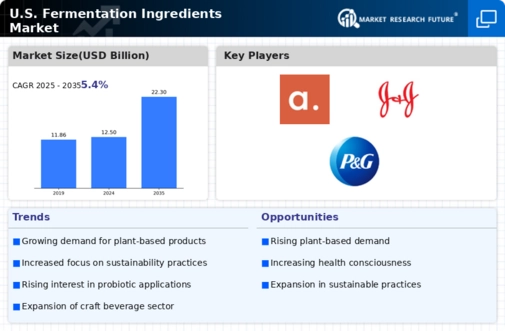Health Consciousness Among Consumers
The increasing health consciousness among consumers is a pivotal driver for the fermentation ingredients market. As individuals become more aware of the benefits of probiotics and fermented foods, the demand for these ingredients surges. This trend is reflected in the market, where the sales of fermented products have seen a notable rise, with a growth rate of approximately 8% annually. Consumers are gravitating towards products that promote gut health, immunity, and overall well-being. This shift in consumer behavior is compelling manufacturers to innovate and incorporate fermentation ingredients into a variety of food and beverage products. This market is thus experiencing a transformation, as companies strive to meet the evolving preferences of health-oriented consumers.
Rising Popularity of Plant-Based Diets
The rising popularity of plant-based diets is emerging as a significant driver for the fermentation ingredients market. As more consumers adopt vegetarian and vegan lifestyles, the demand for plant-based fermented products is increasing. Fermentation not only enhances the nutritional profile of plant-based foods but also improves their digestibility and flavor. The market for plant-based fermented products, such as tempeh and plant-based yogurts, is projected to grow substantially, with estimates suggesting a growth rate of around 10% annually. This shift towards plant-based diets is prompting manufacturers to explore innovative fermentation techniques to create appealing and nutritious products. Consequently, the fermentation ingredients market is likely to expand as it aligns with the evolving dietary preferences of consumers.
Expansion of the Food and Beverage Sector
The expansion of the food and beverage sector in the US is significantly influencing the fermentation ingredients market. With the rise of artisanal and craft food products, there is a growing demand for unique flavors and textures that fermentation can provide. The market for fermented beverages, such as kombucha and kefir, has expanded rapidly, with sales reaching over $1 billion in recent years. This growth is indicative of a broader trend where consumers seek out innovative and diverse culinary experiences. As food manufacturers explore new product lines, the incorporation of fermentation ingredients becomes essential to differentiate their offerings. This dynamic environment fosters opportunities for growth within the fermentation ingredients market, as businesses adapt to the changing landscape of consumer preferences.
Regulatory Support for Fermented Products
Regulatory support for fermented products is playing a crucial role in shaping the fermentation ingredients market. Government initiatives aimed at promoting the consumption of fermented foods, due to their health benefits, are encouraging manufacturers to invest in this sector. The US Department of Agriculture has recognized the importance of fermented foods in dietary guidelines, which may lead to increased funding and research opportunities. This supportive regulatory environment is likely to foster innovation and growth within the fermentation ingredients market, as companies seek to comply with health standards while meeting consumer demand. As regulations evolve, the market may witness a surge in the development of new fermentation ingredients that align with health and safety guidelines.
Technological Advancements in Fermentation Processes
Technological advancements in fermentation processes are driving innovation within the fermentation ingredients market. The development of new fermentation technologies, such as precision fermentation, allows for the production of high-quality ingredients with enhanced efficiency. These advancements not only improve yield but also reduce production costs, making fermentation more accessible to a wider range of manufacturers. As a result, the market is witnessing an influx of novel fermentation ingredients that cater to diverse applications, from food to pharmaceuticals. The ability to produce customized fermentation products is likely to attract investment and research, further propelling the growth of the fermentation ingredients market. This trend suggests a future where fermentation processes are optimized for sustainability and quality.














Leave a Comment